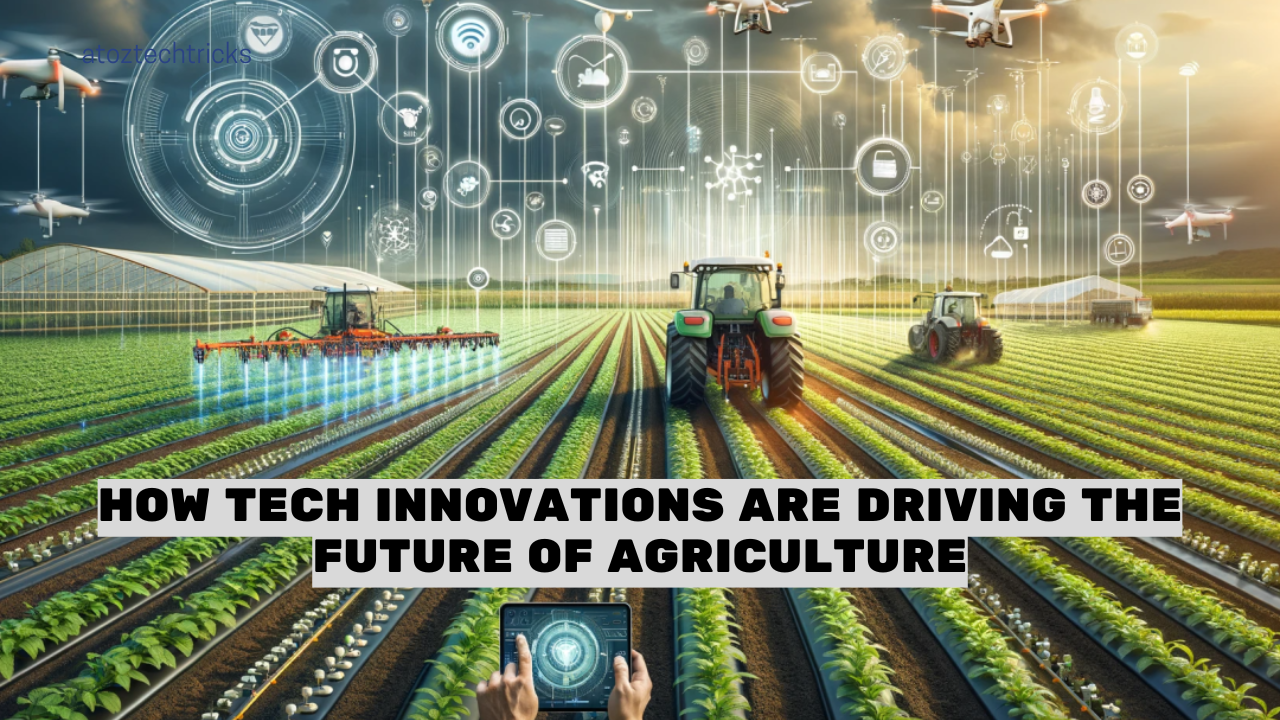Agriculture, one of the oldest and most fundamental human activities, is undergoing a revolutionary transformation. With the global population projected to reach nearly 10 billion by 2050, the demand for food is expected to increase significantly. Traditional farming methods, while time-tested, are no longer sufficient to meet this growing demand. To address this challenge, the agriculture industry is turning to technological innovations that promise to enhance productivity, improve sustainability, and ensure food security. In this article, we will explore the key technological innovations driving the future of agriculture and how they are reshaping the industry.
Precision Agriculture: The Power of Data-Driven Farming
Precision agriculture is one of the most significant advancements in modern farming. This approach involves using technology to monitor and manage the variability of crops and soil within a field. By collecting and analyzing data on factors such as soil conditions, weather patterns, and crop health, farmers can make more informed decisions about planting, irrigation, fertilization, and harvesting.
The Role of GPS and Remote Sensing
Global Positioning System (GPS) technology has become an essential tool in precision agriculture. GPS allows farmers to map their fields with high accuracy, enabling them to track the location of equipment and monitor crop performance in real time. Remote sensing, which involves using drones or satellites to capture images of fields, provides farmers with valuable insights into crop health and soil conditions. These images can reveal areas of stress in crops that may not be visible to the naked eye, allowing farmers to take corrective action before significant damage occurs.
Variable Rate Technology (VRT)
Variable Rate Technology (VRT) is another critical component of precision agriculture. VRT allows farmers to apply inputs such as seeds, fertilizers, and pesticides at varying rates across a field based on the specific needs of different areas. By optimizing the use of inputs, VRT not only increases crop yields but also reduces waste and environmental impact. For example, by applying fertilizer only where it is needed, farmers can minimize runoff into nearby water bodies, reducing the risk of pollution.
The Internet of Things (IoT) in Agriculture
The Internet of Things (IoT) is revolutionizing agriculture by enabling the seamless integration of data from various sources. IoT devices, such as soil sensors, weather stations, and irrigation systems, collect real-time data on environmental conditions and crop health. This data is then transmitted to a central platform, where it can be analyzed to provide actionable insights. For example, IoT-enabled irrigation systems can automatically adjust watering schedules based on soil moisture levels, ensuring that crops receive the right amount of water at the right time.

Robotics and Automation: The Future of Labor in Agriculture
Labour shortages and the rising cost of manual labour are significant challenges facing the agriculture industry. To address these issues, farmers are increasingly turning to robotics and automation to perform tasks that were once done by hand. From planting and harvesting to sorting and packaging, robots are transforming the way agricultural operations are conducted.
Autonomous Tractors and Machinery
Autonomous tractors and machinery are at the forefront of agricultural automation. These vehicles are equipped with GPS, sensors, and cameras that allow them to navigate fields, avoid obstacles, and perform tasks such as ploughing, planting, and spraying with minimal human intervention. Autonomous tractors can operate 24/7, increasing efficiency and allowing farmers to complete tasks in a fraction of the time required by traditional methods.
Robotic Harvesters
Harvesting is one of the most labour-intensive tasks in agriculture, and robotic harvesters are poised to revolutionize this process. These machines use advanced computer vision and artificial intelligence (AI) to identify and pick ripe fruits and vegetables with precision. For example, robotic strawberry harvesters can pick strawberries at a rate of 25,000 per day, far exceeding the capacity of human workers. Additionally, robotic harvesters can work in conditions that are challenging for human labourers, such as extreme temperatures or during night hours.
Drones in Agriculture
Drones are becoming increasingly popular in agriculture for tasks such as crop monitoring, spraying, and planting. Equipped with high-resolution cameras and sensors, drones can capture detailed images of fields, providing farmers with valuable data on crop health and growth patterns. Some drones are also capable of spraying crops with pesticides or fertilizers, offering a more efficient and targeted approach than traditional methods. Furthermore, drones can be used to plant seeds in areas that are difficult to reach by conventional machinery, such as steep hillsides or wetlands.
Biotechnology and Genetic Engineering: Enhancing Crop Resilience and Yields
Biotechnology and genetic engineering are playing a crucial role in the development of crops that are more resilient to environmental stressors and capable of producing higher yields. These innovations are particularly important in the face of climate change, which is expected to increase the frequency and severity of extreme weather events such as droughts, floods, and heat waves.
Genetically Modified Organisms (GMOs)
Genetically Modified Organisms (GMOs) are crops that have been engineered to possess specific traits, such as resistance to pests, diseases, or herbicides. For example, Bt cotton is a GMO crop that produces a protein toxic to certain insects, reducing the need for chemical pesticides. Similarly, herbicide-resistant crops allow farmers to use herbicides more effectively, reducing weed competition and increasing yields.
CRISPR and Gene Editing
CRISPR (Clustered Regularly Interspaced Short Palindromic Repeats) is a powerful gene-editing tool that allows scientists to make precise changes to the DNA of crops. Unlike traditional genetic modification, which involves the insertion of foreign genes, CRISPR can be used to edit the plant’s existing genes, making it a more targeted and potentially less controversial approach. CRISPR has been used to develop crops with improved traits, such as drought tolerance, disease resistance, and enhanced nutritional content. For example, researchers have used CRISPR to develop rice varieties that are more resistant to bacterial blight, a disease that can significantly reduce yields.
Synthetic Biology and Lab-Grown Foods
Synthetic biology, which involves the design and construction of new biological parts, devices, and systems, is opening up new possibilities in agriculture. One of the most exciting developments in this field is the production of lab-grown foods, such as meat and dairy products, which are created from cultured cells rather than traditional livestock. Lab-grown foods have the potential to reduce the environmental impact of agriculture by decreasing the need for land, water, and feed, as well as reducing greenhouse gas emissions.
Artificial Intelligence and Machine Learning: Transforming Decision-Making in Agriculture
Artificial Intelligence (AI) and Machine Learning (ML) are transforming decision-making in agriculture by providing farmers with predictive analytics and insights that were previously unattainable. These technologies are being used to optimize everything from crop management and resource allocation to market forecasting and supply chain logistics.
Predictive Analytics for Crop Management
AI and ML algorithms can analyze vast amounts of data from various sources, such as weather forecasts, satellite imagery, and historical crop performance, to predict future outcomes. For example, AI-powered platforms can provide farmers with recommendations on the best time to plant, irrigate, and harvest their crops based on predicted weather conditions and soil moisture levels. This data-driven approach helps farmers make more informed decisions, reducing the risk of crop failure and increasing overall productivity.
AI in Livestock Management
AI is also being used to improve livestock management by monitoring the health and behaviour of animals. For example, AI-powered cameras and sensors can detect signs of illness or distress in livestock, allowing farmers to intervene before a condition becomes severe. Additionally, AI can be used to optimize feeding schedules and monitor breeding programs, improving the efficiency and profitability of livestock operations.
Market Forecasting and Supply Chain Optimization
AI and ML are not only transforming on-farm operations but are also being used to optimize supply chain logistics and market forecasting. By analyzing data on consumer demand, market trends, and supply chain disruptions, AI can help farmers and agribusinesses make more strategic decisions about when and where to sell their products. This can lead to better pricing strategies, reduced waste, and improved profitability.
Sustainable Agriculture: Innovations for a Greener Future
As concerns about environmental sustainability grow, the agriculture industry is increasingly focused on developing practices and technologies that reduce its environmental impact. From renewable energy and water conservation to sustainable soil management and carbon sequestration, these innovations are driving the future of agriculture towards a greener and more sustainable model.
Renewable Energy in Agriculture
Renewable energy sources, such as solar and wind power, are becoming increasingly popular in agriculture as a way to reduce dependence on fossil fuels and lower greenhouse gas emissions. Solar panels can be installed on farm buildings or in fields to generate electricity for farm operations, while wind turbines can be used to power irrigation systems or other equipment. Additionally, some farmers are using biogas, produced from organic waste such as manure, to generate energy for heating and electricity.
Water Conservation and Irrigation Technology
Water scarcity is a significant challenge for agriculture, particularly in arid regions. To address this issue, farmers are adopting advanced irrigation technologies that optimize water use and reduce waste. Drip irrigation, for example, delivers water directly to the roots of plants, reducing evaporation and runoff. Smart irrigation systems, which are controlled by IoT devices and sensors, can adjust watering schedules based on real-time data on soil moisture and weather conditions, ensuring that crops receive the right amount of water without over-irrigating.
Sustainable Soil Management
Healthy soil is essential for productive agriculture, but intensive farming practices can degrade soil quality over time. To promote sustainable soil management, farmers are adopting practices such as cover cropping, reduced tillage, and crop rotation. These practices help to maintain soil structure, reduce erosion, and improve nutrient cycling. Additionally, technologies such as soil sensors and AI-powered analytics are being used to monitor soil health and guide sustainable management practices.
Carbon Sequestration and Climate-Smart Agriculture
Agriculture is both a contributor to and a victim of climate change. However, it also has the potential to be part of the solution. Carbon sequestration, the process of capturing and storing atmospheric carbon dioxide in soil and plants, is a key strategy for mitigating climate change. Practices such as agroforestry, cover cropping, and reduced tillage can increase the amount of carbon stored in soil, helping to offset greenhouse gas emissions from agriculture. Climate-smart agriculture, which involves adapting farming practices to cope with the impacts of climate change, is also gaining traction as a way to ensure food security in a changing climate.
Vertical Farming and Controlled Environment Agriculture (CEA): Redefining the Future of Food Production
As urbanization continues to expand, there is growing interest in vertical farming and Controlled Environment Agriculture (CEA) as a way to produce food in urban areas. These innovations allow for the cultivation of crops in stacked layers or enclosed environments, where factors such as light, temperature, and humidity can be precisely controlled.
Vertical Farming: Maximizing Space and Efficiency
Vertical farming involves growing crops in vertically stacked layers, often in urban environments such as warehouses or repurposed buildings. This approach maximizes the use of space and allows for year-round production, regardless of external weather conditions. Vertical farms use hydroponic or aeroponic systems to deliver nutrients to plants without the need for soil, reducing water use by up to 90% compared to traditional farming methods. Additionally, vertical farms can be located close to urban centres, reducing the need for transportation and lowering the carbon footprint of food production.
Controlled Environment Agriculture (CEA)
Controlled Environment Agriculture (CEA) refers to the cultivation of crops in a controlled environment, such as a greenhouse or indoor facility, where all aspects of the growing environment can be managed. CEA allows for the production of high-quality, pesticide-free crops with minimal resource inputs. For example, LED lighting can be used to provide plants with the specific wavelengths of light they need for optimal growth, while climate control systems maintain ideal temperature and humidity levels. CEA is particularly well-suited for growing high-value crops such as leafy greens, herbs, and tomatoes, and is increasingly being used to supply fresh produce to urban areas.
Aquaponics and Aquaculture
Aquaponics is an innovative system that combines aquaculture (the raising of fish) with hydroponics (the soil-less cultivation of plants). In an aquaponic system, fish waste provides nutrients for plants, while the plants help to filter and clean the water for the fish. This symbiotic relationship creates a closed-loop system that requires minimal inputs and produces both fish and vegetables. Aquaponics is being used in both rural and urban settings to produce fresh, sustainable food, and is particularly well-suited for areas with limited access to arable land.
The Future of Agriculture is Here
The future of agriculture is being shaped by a wide range of technological innovations that are transforming the way we produce food. From precision agriculture and robotics to biotechnology and sustainable farming practices, these innovations are helping to address the challenges of feeding a growing global population while minimizing environmental impact. As we move forward, we must continue to invest in and adopt these technologies to ensure a sustainable and secure food future for all. The integration of technology into agriculture is not just an option; it is a necessity for the future of our planet and its inhabitants.






